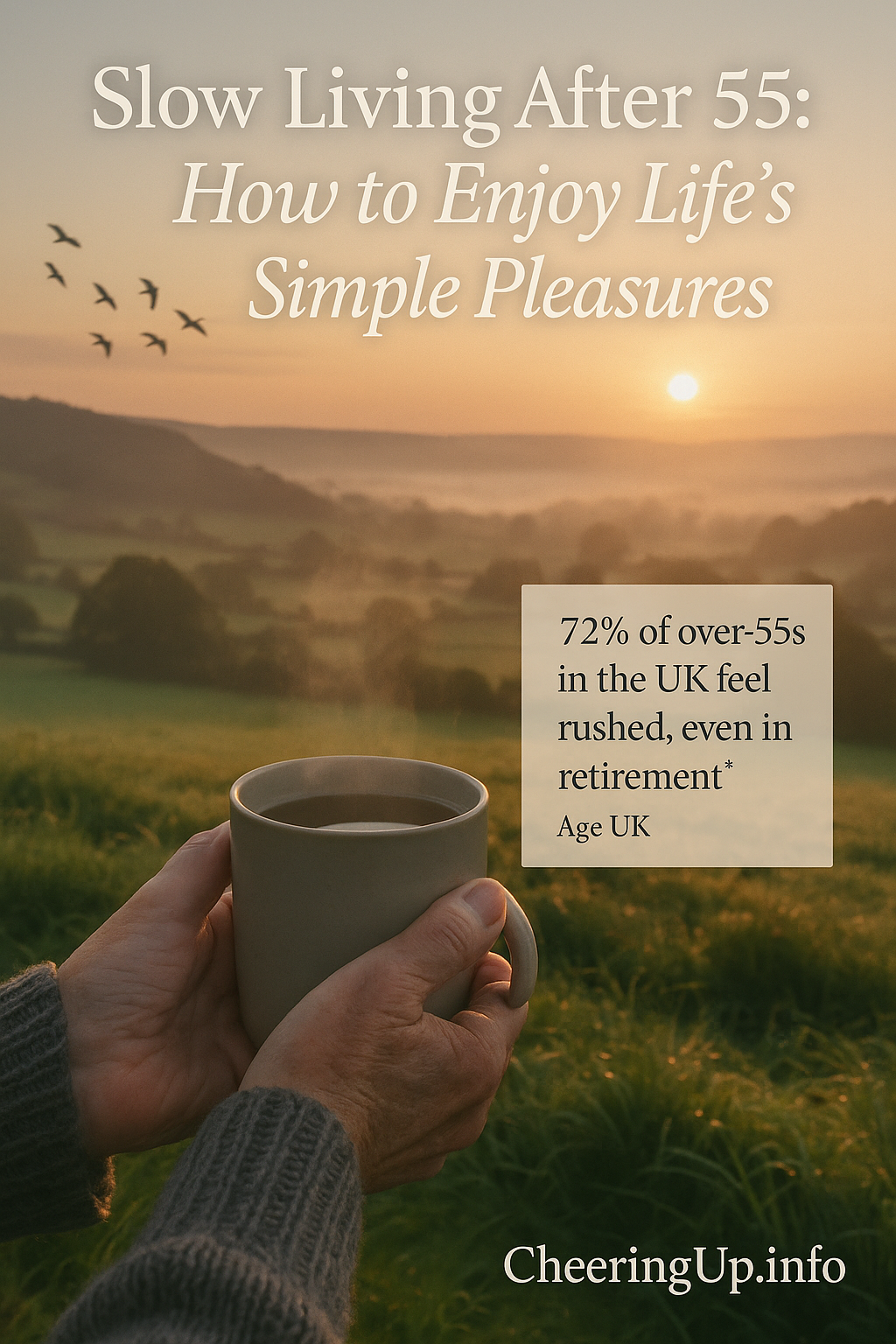The Life-Changing Power of Slow Living for the Over-55s in the UK: A Complete Guide
Why Slow Living Could Be Your Missing Key to Happiness
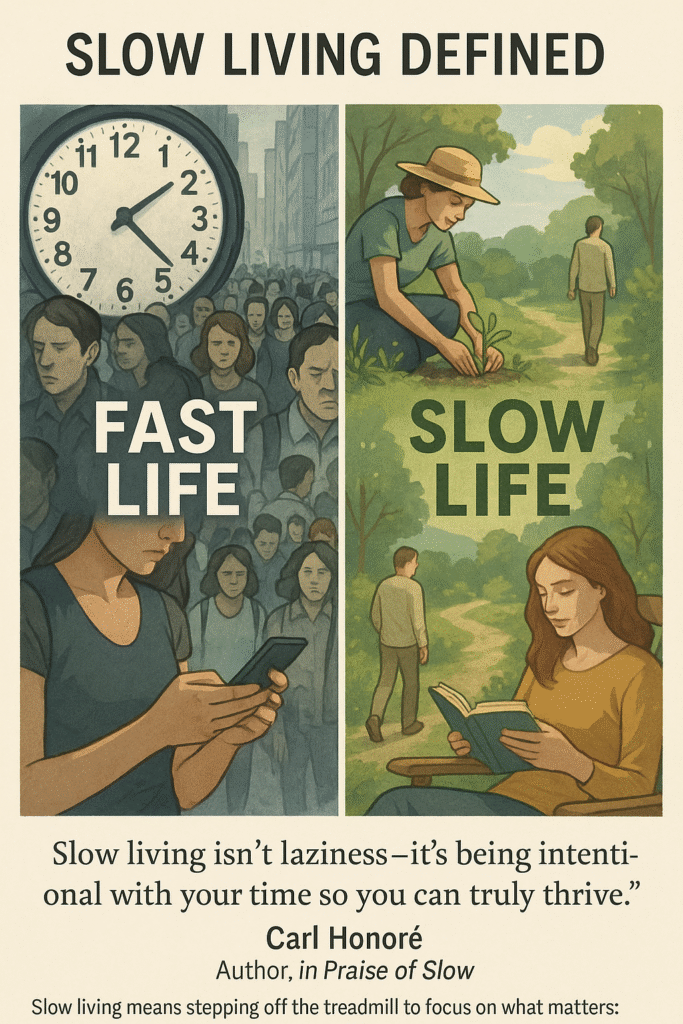
In our hyper-connected, fast-paced world, a quiet revolution is taking place among the UK’s over-55 population. Increasing numbers are discovering that the secret to a fulfilling later life isn’t more – more activities, more possessions, more commitments – but less, done better and with greater presence.
“We’re witnessing a fundamental shift in how people approach their later years,” observes Dr. Sarah Brewer, longevity expert and author of Live Longer, Live Better. “The over-55s are rejecting society’s obsession with speed and productivity in favour of what I call ‘conscious ageing’ – living with intention, attention and appreciation.”
This comprehensive guide goes beyond superficial tips to explore how embracing slow living can transform your health, relationships, finances and overall wellbeing. Packed with:
- Groundbreaking scientific research on ageing and wellbeing
- Real-life case studies from UK slow living practitioners
- Expert insights from gerontologists, financial planners and lifestyle coaches
- Practical challenges and action plans you can implement immediately
Whether you’re approaching retirement, recently retired or well into your later years, this guide will show you how to craft a life of greater meaning, connection and joy by embracing the power of slow.
The Science and Philosophy of Slow Living
Understanding the Slow Living Movement
Slow living isn’t about doing everything at a snail’s pace – it’s about doing the right things at the right pace. Emerging from Italy’s Slow Food Movement in the 1980s as a protest against fast food culture, the philosophy has since expanded into a comprehensive approach to modern living.
“Slow living is essentially about reclaiming your attention and aligning your daily life with your deepest values,” explains Carl Honoré, author of the international bestseller In Praise of Slow. “For the over-55s, it offers particularly powerful benefits because it helps counteract many of the psychological and physiological challenges of ageing.”
Why Slow Living Resonates with the Over-55s
A 2023 study by Age UK revealed startling statistics:
- 72% of over-55s reported feeling “constantly rushed” despite being retired
- 65% said they experienced more stress post-retirement than anticipated
- 82% wished they had more “quality time” with loved ones
Dr. Rebecca Harris, gerontologist at the University of Bristol, explains: “As we age, our relationship with time fundamentally changes. The over-55s often experience what we call ‘time compression’ – the sensation that time is accelerating. Slow living practices help expand our perception of time by bringing us into the present moment.”
The Neuroscience of Slowing Down
Groundbreaking research in neuroplasticity shows that our brains remain adaptable throughout life. A 2022 Cambridge University study found that mindfulness practices common in slow living:
- Increase grey matter density in memory-related brain regions
- Strengthen the prefrontal cortex, improving decision-making
- Reduce amygdala activity, decreasing stress responses
“What’s remarkable,” notes Dr. Harris, “is that these changes were particularly pronounced in participants over 60, suggesting older brains may be especially responsive to slow living practices.”
The Transformative Health Benefits of Slow Living
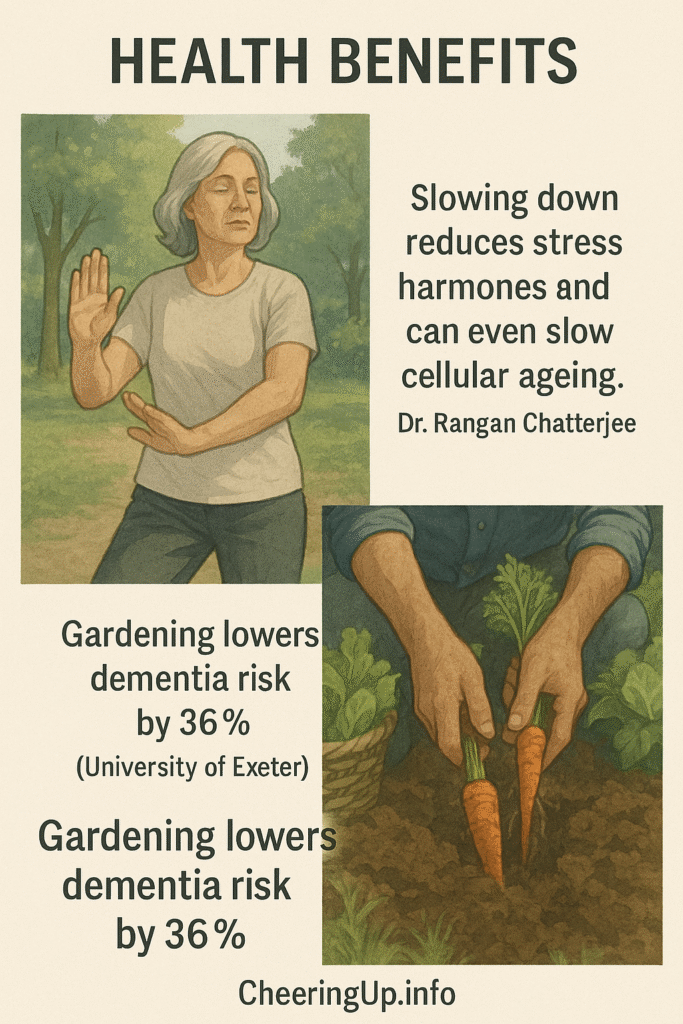
1. Mental Wellbeing: From Stress to Serenity
Dr. Rangan Chatterjee, BBC presenter and author of The Stress Solution, explains: “Chronic stress accelerates cellular ageing through telomere shortening. Slow living practices like mindfulness and nature immersion activate the parasympathetic nervous system, which acts as an anti-ageing mechanism.”
Case Study: Margaret’s Transformation
Margaret, 67, a retired teacher from Brighton, struggled with:
- Chronic insomnia
- Retirement-related anxiety
- Feeling “useless” without work structure
Her slow living prescription:
- Digital sunset (no screens after 7pm)
- Morning pages journaling (3 handwritten pages each morning)
- Daily “forest bathing” in Stanmer Park
“Within three months, my sleep improved dramatically,” Margaret reports. “I’ve rediscovered my love for watercolours and actually enjoy my own company now.”
2. Physical Health: Movement That Matters
Unlike punishing exercise regimens, slow living promotes sustainable movement:
| Activity | Proven Benefits | Ideal For |
|---|---|---|
| Tai Chi | Improves balance (reducing fall risk by 43%) | Arthritis sufferers |
| Gardening | Lowers dementia risk by 36% (Exeter University) | Those with limited mobility |
| Nordic Walking | 40% more calorie burn than regular walking | Cardiovascular health |
“The key is consistency over intensity,” emphasises Dr. Muir Gray, NHS adviser on healthy ageing. “Ten minutes of daily gentle movement beats one hour of weekly intense exercise for longevity benefits.”
3. Cognitive Benefits: Keeping the Mind Agile
Dr. Angela Clow’s research at Westminster University demonstrates how slow hobbies create cognitive reserve:
- Learning a language: Increases grey matter density
- Playing chess: Enhances strategic thinking
- Playing musical instruments: Improves neural connectivity
“The brain needs novelty, but without time pressure,” Dr. Clow explains. “This combination is perfect for maintaining cognitive function as we age.”
Slow Travel – The Art of Journeying Mindfully
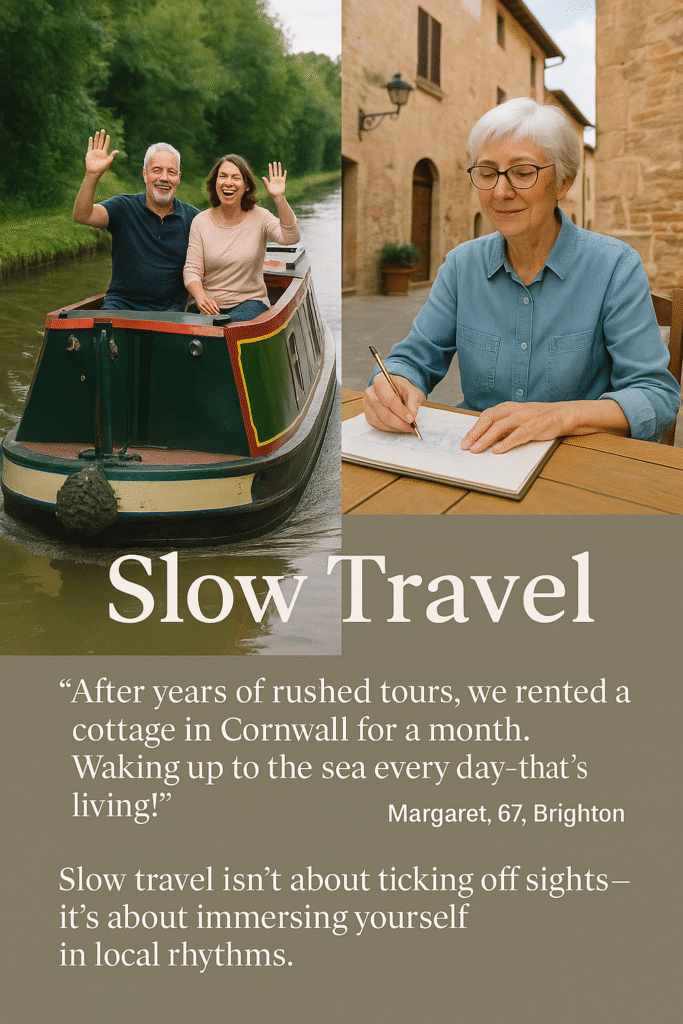
Why Slow Travel Transforms Later-Life Adventures
Pauline Kenny, founder of Slow Europe, observes: “Traditional tourism often leaves older travellers exhausted. Slow travel aligns perfectly with the needs of over-55s by prioritising depth over distance, experience over checklist tourism.”
The Slow Travel Advantage:
| Traditional Travel | Slow Travel |
|---|---|
| Packed itineraries | Spontaneous exploration |
| Tourist hotspots | Local hidden gems |
| Jet lag | Natural rhythms |
| Surface experiences | Meaningful connections |
Inspiring Slow Travel Ideas for Over-55s
UK Canal Boating Holidays
- Route suggestion: The Llangollen Canal (7 days)
- Highlights:
- Walking pace travel (max 4mph)
- Quaint waterside pubs
- Operating locks (gentle physical activity)
- Cost: From £1,200/week (shared between 4)
“It’s the perfect blend of gentle adventure and relaxation,” says Derek, 71, who holidays annually with his canal boat group.
European House Sitting
- How it works: Care for homes/pets in exchange for free accommodation
- Best platforms: TrustedHousesitters, MindMyHouse
- Ideal locations: Rural France, Italian countryside
Case Study: Susan’s Year of Slow Travel
Susan, 68, spent 2023 house sitting in:
- A Provençal vineyard
- A Tuscan farmhouse
- A Portuguese coastal village
“I’ve lived like a local across Europe for a fraction of hotel costs,” she says.
Pilgrimage Walking (The Slowest Travel)
- Camino de Santiago: The Portuguese route (gentler terrain)
- UK alternatives:
- St Cuthbert’s Way (Scotland/England border)
- Pilgrims’ Way to Canterbury
Slow Home Living – Creating Your Personal Sanctuary
The Psychology of Slow Spaces
Julia Atkinson-Dunn, slow living advocate and author, explains: “Our homes should be our sanctuaries, especially as we age. A slow home isn’t about aesthetic perfection – it’s about creating spaces that support how you truly want to live.”
The 5 Pillars of Slow Home Living:
Intentional Spaces
- Designate areas for specific activities (reading nook, craft corner)
- Remove multi-purpose clutter
Natural Elements
- Maximise natural light
- Incorporate wood, stone and plants
Tech Boundaries
- Create screen-free zones
- Implement “digital sunsets”
Sensory Comfort
- Soft textiles
- Soothing colour palettes
- Ambient lighting
Ease of Movement
- Age-friendly design
- Clear pathways
- Comfortable seating
Case Study: John & Linda’s Downsizing Journey
This York couple transformed their living space by:
- Implementing the “one in, one out” rule
- Creating a dedicated slow living room (no TV, just books and music)
- Designing a low-maintenance garden with raised beds
“Our home now feels like a daily retreat rather than a maintenance burden,” Linda shares.
Slow Finances – Redefining Wealth in Later Life

The New Retirement Economics
Sarah Coles, personal finance analyst at Hargreaves Lansdown, notes: “The traditional retirement model is broken. People are living longer but often worrying more about money. Slow finances offer a sustainable alternative.”
Principles of Slow Finance:
‘Enough Mindset’
- Distinguish between needs and wants
- Practice conscious consumption
Sustainable Withdrawal Strategies
- The 3.5% rule (safer than traditional 4%)
- Bucket strategy for market downturns
Experimental Spending
- Prioritise meaningful experiences
- The “20-year test” (“Will this matter in 20 years?”)
Case Study: Geoff’s Investment Transformation
Geoff, 68, shifted from active trading to slow investing:
- Moved to dividend-paying stocks
- Implemented a three-bucket system:
- Immediate cash needs
- 3-5 year bonds
- Long-term growth funds
“I sleep better and my portfolio grows steadily,” he reports.
Your 7-Day Slow Living Challenge
Day 1: Digital Detox
- No screens before breakfast/after dinner
- Try analog alternatives (physical books, handwritten letters)
Day 2: Mindful Eating
- Prepare one meal from scratch
- Eat without distractions
Day 3: Nature Immersion
- 30+ minutes outdoors
- Practice “forest bathing”
Day 4: Financial Review
- Cancel one unused subscription
- Set up a “slow spending” tracker
Day 5: Social Slowdown
- One quality conversation (no multitasking)
- Write a heartfelt letter
Day 6: Home Sanctuary
- Declutter one space
- Create a slow living corner
Day 7: Reflection
- Journal about your experience
- Plan ongoing slow living practices
Conclusion: Your Slow Living Blueprint
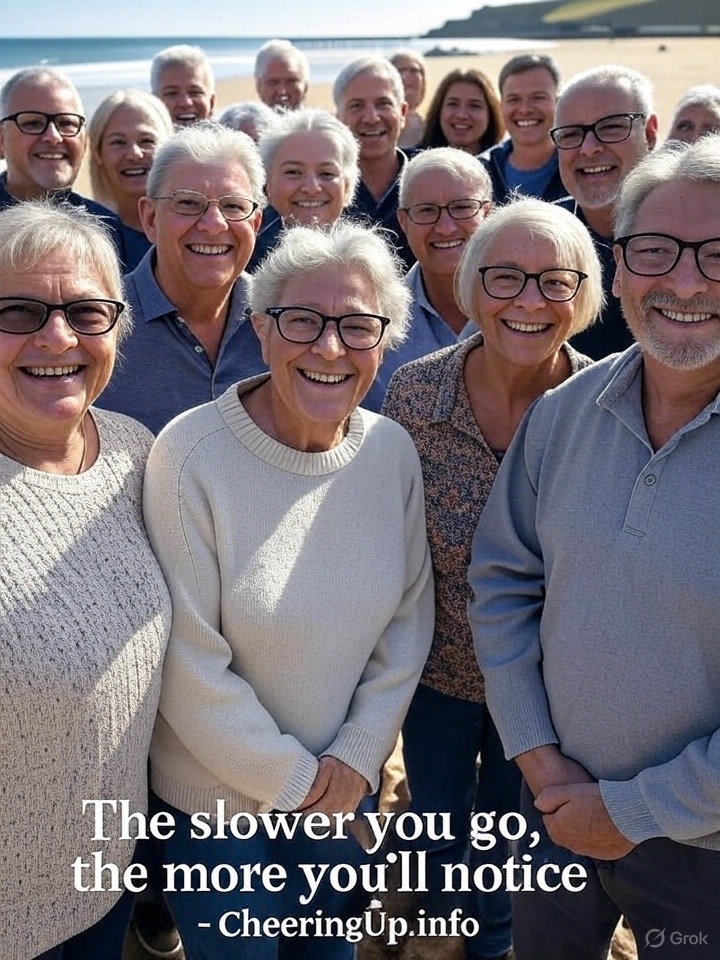
Slow living isn’t about withdrawing from life – it’s about engaging with it more deeply. As Dr. Brewer concludes: “The slower you go, the more you’ll discover that true richness comes not from accumulation, but from appreciation.”
Your Next Steps:
- Start small – Pick one element from this guide to implement
- Build gradually – Add new practices as habits form
- Share the journey – Inspire others in your community
Remember, as Carl Honoré reminds us: “Slowing down isn’t about giving up – it’s about gearing up for what truly matters.” Your most fulfilling years may well be ahead of you, waiting to be discovered at the perfect pace – yours.
Join our Retirement Club today
Get help to protect and grow your business faster with CheeringUpInfo
Find out more about Lifestyle Improvement Club Corporate Membership here
Subscribe for free retirement lifestyle improvement tips reviews and money saving ideas
Connect with us for free retirement lifestyle improvement tips
Read more retirement lifestyle improvement articles and view videos for free
Read and view more:
How to embrace slow living after retirement UK
Best slow travel ideas for seniors in the UK
Mindful living tips for over 55s to reduce stress
Simple living strategies for UK retirees on a budget
Archived articles:
1. #SlowLivingUK
2. #Over55AndThriving
3. #MindfulRetirement
4. #SlowTravelUK
5. #SimplifyAfter50
Bonus Articles :
- #UKRetirementLife
- #ConsciousAgeing
Slow living benefits for over 55s in the UK
